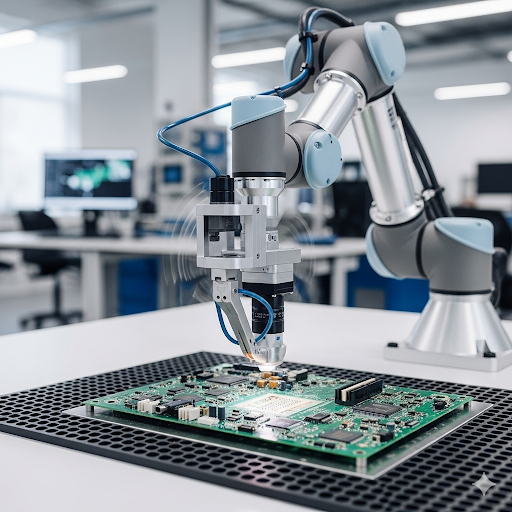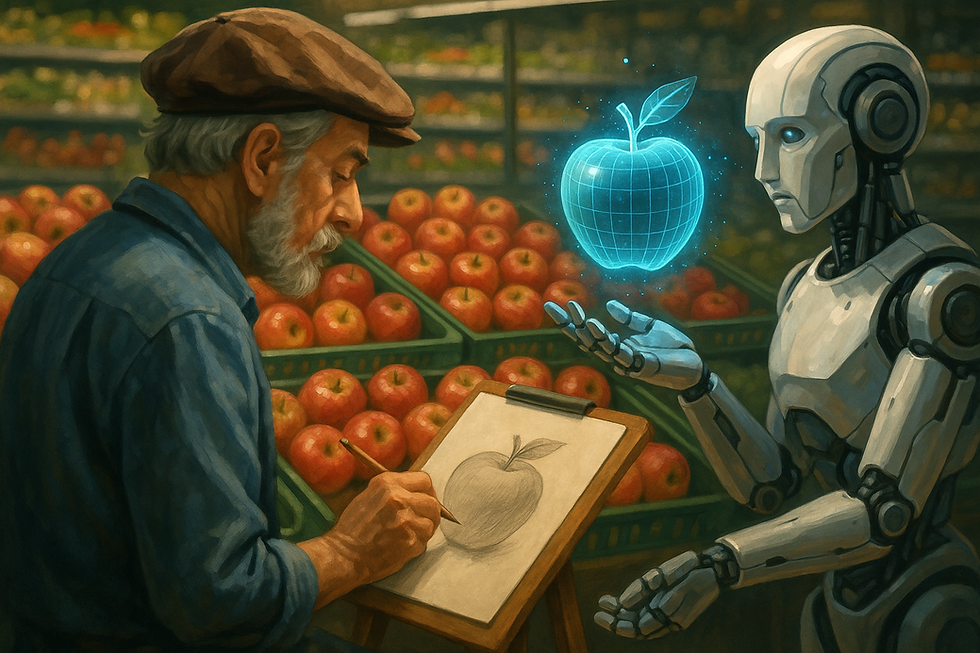Choosing the Right Scale and Tasks: Making SDG Work for Your AI Projects
- Ting-Yuan Wang
- Sep 4
- 6 min read
Updated: Sep 8

How Corvus's synthetic data generation platform addresses the critical challenge of matching model capabilities with data requirements
The Data Challenge: When More Isn't Always Better
AI systems are perpetually hungry for data. Whether it's training computer vision models to detect manufacturing defects, developing autonomous vehicles, or building medical diagnostic tools, the demand for high-quality training data far exceeds our ability to collect it manually.
This is where synthetic data generation (SDG) comes in. What started as researchers using video game graphics to train AI models has evolved into a sophisticated technology that's reshaping how we approach machine learning. However, not every AI project benefits equally from synthetic data, and the success of SDG implementation depends heavily on understanding the relationship between model scale, task requirements, and data characteristics.
At Corvus, we've discovered that the key to successful SDG implementation isn't just about having the technology—it's about knowing when and how to use it effectively.
The Counter-Intuitive Reality: Why Bigger Models Need Better Data
The Learning Paradox
Here's a counter-intuitive phenomenon that many organizations discover the hard way: large models actually require higher quality synthetic data than smaller models. This seems contradictory—after all, shouldn't larger models be better at generalizing and handling noisy data?
The answer lies in understanding how different model scales learn. Large models can learn many abstract concepts and have strong learning capabilities, but they also learn many incorrect things. This is why large models need diverse data for training, but simultaneously require very high quality to ensure model performance.
Small models (like MobileNet-V2 with 3.4M parameters) are like "snipers"—they have limited learning capacity but can excel at specific tasks. When they encounter high-quality synthetic data, they quickly learn and adapt. Even if synthetic data has slight imperfections, small models might not "notice" them, leading to clear performance improvements.
Large models (like ResNet-152 with 60M+ parameters) are like "generalists"—they can detect subtle unnatural aspects in synthetic data. If synthetic data quality is inconsistent, large models will learn incorrect patterns, potentially leading to catastrophic forgetting and performance degradation.
The Three-Stage Learning Approach
Modern large language models typically follow three scaling laws, with different learning objectives at each stage:
Pre-training: Using synthetic data to learn semantics
Post-training: Fine-tuning with real data for domain adaptation
Inference: Applying learned knowledge to new tasks
In contrast, CNNs directly replace real data with synthetic data, performing data randomization and adaptation in one step. This fundamental difference explains why the choice of SDG approach should match your model's complexity and learning capabilities.
Task-Specific SDG Requirements: The Three Pillars of Visual AI
Visual Classification: The "Philosopher" Approach
Visual classification tasks are like "philosophers"—they need to understand global image semantics without focusing on detailed positional information. This characteristic makes visual classification tasks relatively adaptable to synthetic data.
In visual classification, models primarily learn overall object features and semantic information. Even if synthetic data differs from real data in details, as long as global semantics remain consistent, models can usually generalize well.
For small models: Randomization aims to make images look like real photographs, because models can't learn deep physical logic.
For large models: Randomization's purpose becomes showing models the logic of physical variations, such as how lighting and materials affect observations, so the randomization space is physical effects, not whether the image looks realistic.
Object Detection: The "Surveyor" Approach
Object detection tasks are like "surveyors"—they not only need to identify objects but also precisely locate their positions and sizes. This precision requirement makes object detection tasks more sensitive to synthetic data quality.
While CNNs have translation equivariance, in practice, bounding box cropping can significantly reduce background interference and positioning errors, improving accuracy for recognition tasks. For end-to-end recognition tasks, the "detect bounding box first, then classify" two-stage architecture (like Faster R-CNN) typically performs better, unless using Transformer-based models (like DETR) with built-in attention positioning capabilities.
Semantic Segmentation: The "Artist" Approach
Semantic segmentation tasks are like "artists"—they need to classify each pixel precisely, requiring the highest quality synthetic data. Models must learn precise boundary information, demanding synthetic data with extremely high realism in materials, lighting, shadows, and other details.
Even small visual differences can lead to inaccurate segmentation boundaries, making this the most challenging task for SDG implementation.
Corvus's Solution: Strategic SDG Implementation
The Core Philosophy: "Give Me 3D Models, I'll Give You AI"
At Corvus, our core philosophy is simple yet powerful: "Give me some 3D models and I will give you an AI model." This approach addresses the fundamental pain point of not needing to collect massive amounts of 2D images as training data, resulting in significant savings in time, human resources, and costs.
Our solution leverages the advantages of synthetic data while embracing its challenges. The benefits include low data costs, but the challenge lies in having sufficient domain knowledge to make synthetic data effective—effective for AI learning internally and effective for meeting usage scenarios externally.
Technical Architecture: The Corvus Pipeline
3D Rendering Engine: Using Blender for high-quality 3D rendering with precise control over object pose, lighting, materials, and backgrounds.
Automated Annotation: Synthetic images automatically generate complete category annotations, enabling rapid generation of tens of thousands of diverse training samples.
Domain Randomization: Implementing sophisticated randomization strategies to bridge the sim2real gap while maintaining data quality.
Multi-Model Support: Compatible with various model architectures (Hiera, SEBlocksNet, etc.) and deployment scenarios.
Real-World Results
In industrial parts classification tasks, our approach achieves:
95%+ accuracy in industrial parts classification
60% reduction in development cycle time compared to traditional data collection methods
70% cost reduction in data acquisition and labeling
Support for multiple model architectures and deployment scenarios
Strategic Implementation Framework
Model Scale Considerations
Small Models (<100M parameters):
Best for: Simple classification tasks and resource-constrained environments
SDG Strategy: High-quality, targeted synthetic data
Focus: Data annotation accuracy and task relevance
Medium Models (100M-1B parameters):
Best for: Balanced performance requirements
SDG Strategy: Balance between data diversity and task specificity
Focus: Generalization capability and overfitting prevention
Large Models (>1B parameters):
Best for: Complex tasks and high-performance requirements
SDG Strategy: Large-scale, diverse synthetic datasets
Focus: Computational efficiency and deployment costs
Task-Specific Strategies
Visual Classification: Lower quality requirements, focus on global semantic consistency, can use simpler synthetic data generation methods.
Object Detection: Higher geometric realism requirements, focus on object position and size accuracy, recommend high-quality 3D rendering techniques.
Semantic Segmentation: Highest detail realism requirements, focus on boundary and material accuracy, recommend physical simulation and material scanning techniques.
The Future: Becoming SDG Strategy Experts
The sim2real gap research spans from small CNN models to large VLM models, creating ongoing demand. We believe Corvus has value in pursuing this direction—we can become experts in solving sim2real gap problems, specializing in data science challenges where AI is just a tool.
Key Takeaways
Synthetic data is closely related to AI:
What should AI learn? What can AI learn?
For small models: Randomization aims to make images look like real photographs
For large models: Randomization shows models the logic of physical variations
In the CNN era, we care about whether image output covers real variation ranges, so we can randomly place lighting as long as the result looks good.
In the VLM era, we care about whether models can learn "this is realistic light-object interaction in the real world," so even if lighting is randomly placed, the resulting physical effects must be correct, otherwise models can't learn these underlying patterns.
Ready to Transform Your AI Development?
The future of SDG isn't just about better technology—it's about smarter implementation. Organizations that understand how to match SDG strategies with their specific AI needs will gain significant competitive advantages.
As we move forward, the focus will shift from "Can we generate synthetic data?" to "Should we generate synthetic data for this specific use case?" This strategic approach will be crucial for maximizing ROI and ensuring successful AI deployments.
Discover how Corvus's synthetic data solutions can help you:
Overcome data scarcity challenges in specialized domains
Accelerate AI development with 3D model-based training
Achieve your machine learning goals while maintaining cost efficiency
Bridge the sim2real gap with domain expertise
About Corvus
Corvus specializes in enterprise-grade synthetic data generation solutions, combining cutting-edge 3D rendering technology with practical business applications. Our platform enables organizations to leverage the power of synthetic data for machine learning and AI development, particularly in scenarios where traditional data collection is costly or impractical.
Learn more about Corvus solutions: [Contact our team for a consultation]
Ready to get started? Let's discuss how Corvus can help you implement the right SDG strategy for your specific AI projects.
This article is part of Corvus's SDG series, exploring how synthetic data generation can be strategically implemented to maximize AI project success. Stay tuned for our next article on Physical AI applications and advanced SDG techniques. #SyntheticDataGeneration #AIInnovation#DataScience #Corvus #AIStrategy #TechTrends


